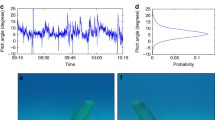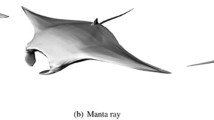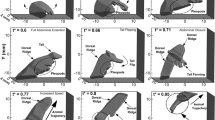Abstract
Turning is important for ecological success in the oceans. It is essential for capturing prey, escaping predators, and navigating complex environments. Although squids are central to food web dynamics, little is known quantitatively about their turning dynamics. To assess turning capacity of neritic squids, quantify the role of propulsors and orientation in turning, and determine if jet flow is predictive of performance, kinematic and 3D velocimetry data were collected from the longfin squid Doryteuthis pealeii and shortfin squid Illex illecebrosus and combined with a subset of data from a prior study of brief squid Lolliguncula brevis. All animals were captured in Maine (43.8° N, 69.6° W) and Virginia (37.6° N, 75.7° W) waters. Experiments were conducted in July–October 2018 and 2019. Lolliguncula brevis was the most proficient at turning, with the highest mean and maximum angular velocity (\(\varOmega\)mean, \(\varOmega\)max) and the lowest minimum length-specific turning radius (R/Lmin). Relative to the fins, the pulsed jet contributed to a greater percentage of impulse magnitude and angular impulse (71–72%) during turns in all squids. Arms-first turns, which were powered by short jets, were associated with lower mean and minimum length-specific turning radii (R/Lmean, R/Lmin) than tail-first turns. Greater \(\varOmega\)mean and \(\varOmega\)max were achieved during tail-first turns for L. brevis and I. illecebrosus and arms-first turns for D. pealeii, with jet velocity/impulse being the primary factor contributing to these differences. While the jet was the main driver of turns, no one jet property predicted performance across the squids, with jet length-to-diameter ratio, velocity, and frequency all playing roles.










Similar content being viewed by others
Data availability
The datasets generated and/or analyzed during the current study are available from the corresponding author on reasonable request.
References
Anderson E, Demont ME (2005) The locomotory function of the fins in the squid Loligo pealei. Mar Freshw Behav Physiol 38:169–189. https://doi.org/10.1080/10236240500230765
Anderson EJ, Grosenbaugh MA (2005) Jet flow in steadily swimming adult squid. J Exp Biol 208:1125–1146. https://doi.org/10.1242/jeb.01507
Bartol IK, Mann R, Patterson MR (2001a) Aerobic respiratory costs of swimming in the negatively buoyant brief squid Lolliguncula brevis. J Exp Biol 204:3639–3653. https://doi.org/10.1242/jeb.204.21.3639
Bartol IK, Patterson MR, Mann R (2001b) Swimming mechanics and behavior of the shallow-water brief squid Lolliguncula brevis. J Exp Biol 204:3655–3682. https://doi.org/10.1242/jeb.204.21.3655
Bartol IK, Mann R, Vecchione M (2002) Distribution of the euryhaline squid Lolliguncula brevis in Chesapeake Bay: effects of selected abiotic factors. Mar Ecol Prog Ser 226:235–247. https://doi.org/10.3354/meps226235
Bartol IK, Krueger PS, Thompson JT, Stewart WJ (2008) Swimming dynamics and propulsive efficiency of squids throughout ontogeny. Integr Comp Biol 48:720–733. https://doi.org/10.1093/icb/icn043
Bartol IK, Krueger PS, Stewart WJ, Thompson JT (2009a) Hydrodynamics of pulsed jetting in juvenile and adult brief squid Lolliguncula brevis: evidence of multiple jet `modes’ and their implications for propulsive efficiency. J Exp Biol 212:1889–1903. https://doi.org/10.1242/jeb.027771
Bartol IK, Krueger PS, Stewart WJ, Thompson JT (2009b) Pulsed jet dynamics of squid hatchlings at intermediate Reynolds numbers. J Exp Biol 212:1506–1518. https://doi.org/10.1242/jeb.026948
Bartol IK, Krueger PS, Jastrebsky RA et al (2016) Volumetric flow imaging reveals the importance of vortex ring formation in squid swimming tail-first and arms-first. J Exp Biol 219:392–403. https://doi.org/10.1242/jeb.129254
Bartol IK, Krueger PS, York CA, Thompson JT (2018) New approaches for assessing squid fin motions: coupling proper orthogonal decomposition with volumetric particle tracking velocimetry. J Exp Biol 221:jeb176750. https://doi.org/10.1242/jeb.176750
Bartol IK, Ganley AM, Tumminelli AN et al (2022) Vectored jets power arms-first and tail-first turns differently in brief squid with assistance from fins and keeled arms. J Exp Biol 225:jeb244151. https://doi.org/10.1242/jeb.244151
Boyle P, Rodhouse P (2005) Cephalopods: ecology and fisheries. Blackwell Publishing
Bradbury HE, Aldrich FA (1969) Observations on locomotion of the short-finned squid, Illex illecebrosus illecebrosus (Lesueur, 1821), in captivity. Can J Zool 47:741–744. https://doi.org/10.1139/z69-128
Cones SF, Zhang D, Shorter KA et al (2022) Swimming behaviors during diel vertical migration in veined squid Loligo forbesii. Mar Ecol Prog Ser 691:83–96. https://doi.org/10.3354/meps14056
Couch LD, Krueger PS (2011) Experimental investigation of vortex rings impinging on inclined surfaces. Exp Fluids 51:1123–1138. https://doi.org/10.1007/s00348-011-1135-x
Dabiri JO (2009) Optimal vortex formation as a unifying principle in biological propulsion. Annu Rev Fluid Mech 41:17–33. https://doi.org/10.1146/annurev.fluid.010908.165232
Dabiri JO (2019) Landmarks and frontiers in biological fluid dynamics. Phys Rev Fluids 4:110501. https://doi.org/10.1103/PhysRevFluids.4.110501
Dabiri JO, Colin SP, Gemmell BJ et al (2020) Jellyfish and fish solve the challenges of turning dynamics similarly to achieve high maneuverability. Fluids 5:106. https://doi.org/10.3390/fluids5030106
Dawe E, Beck P, Drew H, Winters G (1981) Long-distance migration of a short-finned squid, Illex illecebrosus. J Northwest Atl Fish Sci 2:75–76. https://doi.org/10.2960/J.v2.a10
Domenici P, Blake R (1997) The kinematics and performance of fish fast-start swimming. J Exp Biol 200:1165–1178. https://doi.org/10.1242/jeb.200.8.1165
FAO (2022) The state of world fisheries and aquaculture 2022. Towards blue transformation. FAO, Rome
Fish FE, Holzman R (2019) Swimming turned on its head: stability and maneuverability of the shrimpfish (Aeoliscus punctulatus). Integr Org Biol 1:obz025. https://doi.org/10.1093/iob/obz025
Fish FE, Kolpas A, Crossett A et al (2018) Kinematics of swimming of the manta ray: three-dimensional analysis of open-water maneuverability. J Exp Biol 221:jeb166041. https://doi.org/10.1242/jeb.166041
Foyle TP, O’dor RK (1988) Predatory strategies of squid (Illex illecebrosus) attacking small and large fish. Mar Freshw Behav Phy 13:155–168. https://doi.org/10.1080/10236248809378670
Gemmell BJ, Troolin DR, Costello JH et al (2015) Control of vortex rings for manoeuvrability. J R Soc Interface 12:20150389. https://doi.org/10.1098/rsif.2015.0389
Gharib M, Rambod E, Shariff K (1998) A universal time scale for vortex ring formation. J Fluid Mech 360:121–140. https://doi.org/10.1017/S0022112097008410
Gharib M, Pereira F, Dabiri D et al (2002) Quantitative flow visualization: toward a comprehensive flow diagnostic tool. Integr Comp Biol 42:964–970. https://doi.org/10.1093/icb/42.5.964
Hanlon RT, Messenger JB (2018) Cephalopod behaviour, 2nd edn. Cambridge University Press
Hanlon RT, Hixon RF, Hulet WH (1983) Survival, growth, and behavior of the loliginid squids Loligo plei, Loligo pealei, and Lolliguncula brevis (Mollusca: Cephalopoda) in closed sea water systems. Biol Bull 165:637–685. https://doi.org/10.2307/1541470
Hedrick TL (2008) Software techniques for two-and three-dimensional kinematic measurements of biological and biomimetic systems. Bioinspir Biomim 3:034001. https://doi.org/10.1088/1748-3182/3/3/034001
Hixon RF (1980) Growth, reproductive biology, distribution and abundance of three species of loliginid squid (Myopsida, Cephalopoda) in the Northwest Gulf of Mexico. University of Miami
Hoar JA, Sim E, Webber DM, O’Dor RK (1994) The role of fins in the competition between squid and fish. In: Maddock L, Bone Q, Rayner JMV (eds) Mechanics and physiology of animal swimming. Cambridge University Press, Cambridge, pp 27–43
Howland HC (1974) Optimal strategies for predator avoidance: the relative importance of speed and manoeuvrability. J Theor Biol 47:333–350. https://doi.org/10.1016/0022-5193(74)90202-1
Hurley G, Dawe E (1980) Tagging studies on squid (Illex illecebrosus) in the Newfoundland area. Northw Fish Org Set Res Coun Doc 72:11
Jastrebsky RA, Bartol IK, Krueger PS (2016) Turning performance in squid and cuttlefish: unique dual-mode, muscular hydrostatic systems. J Exp Biol 219:1317–1326. https://doi.org/10.1242/jeb.126839
Jastrebsky RA, Bartol IK, Krueger PS (2017) Turning performance of brief squid Lolliguncula brevis during attacks on shrimp and fish. J Exp Biol 220:908–919. https://doi.org/10.1242/jeb.144261
Kajitani L, Dabiri D (2005) A full three-dimensional characterization of defocusing digital particle image velocimetry. Meas Sci Technol 16:790. https://doi.org/10.1088/0957-0233/16/3/022
Kier WM, Thompson JT (2003) Muscle arrangement, function and specialization in recent coleoids. Berl Paläobiologische Abh 3:141–162
Krueger PS, Gharib M (2003) The significance of vortex ring formation to the impulse and thrust of a starting jet. Phys Fluids 15:1271–1281. https://doi.org/10.1063/1.1564600
Leahy AM, Fish FE, Kerr SJ et al (2021) The role of California sea lion (Zalophus californianus) hindflippers as aquatic control surfaces for maneuverability. J Exp Biol 224:jeb243020. https://doi.org/10.1242/jeb.243020
Macy WK III (1980) The ecology of the common squid Loligo pealei Lesueur, 1821 in Rhode Island waters. University of Rhode Island
McCormick LR, Cohen JH (2012) Pupil light reflex in the Atlantic brief squid, Lolliguncula brevis. J Exp Biol 215:2677–2683. https://doi.org/10.1242/jeb.068510
Muramatsu K, Yamamoto J, Abe T et al (2013) Oceanic squid do fly. Mar Biol 160:1171–1175. https://doi.org/10.1007/s00227-013-2169-9
O’Dor RK (1988) The forces acting on swimming squid. J Exp Biol 137:421–442. https://doi.org/10.1242/jeb.137.1.421
O’Dor RK, Webber D (1991) Invertebrate athletes: trade-offs between transport efficiency and power density in cephalopod evolution. J Exp Biol 160:93–112. https://doi.org/10.1242/jeb.160.1.93
O’Dor RK, Stewart J, Gilly W et al (2013) Squid rocket science: how squid launch into air. Deep-Sea Res II 95:113–118. https://doi.org/10.1016/j.dsr2.2012.07.002
Packard A (1969) Jet propulsion and the giant fibre response of Loligo. Nature 221:875–877. https://doi.org/10.1038/221875a0
Pereira F, Gharib M (2002) Defocusing digital particle image velocimetry and the three-dimensional characterization of two-phase flows. Meas Sci Technol 13:683–694. https://doi.org/10.1088/0957-0233/13/5/305
Pereira F, Gharib M (2004) A method for three-dimensional particle sizing in two-phase flows. Meas Sci Technol 15:2029–2038. https://doi.org/10.1088/0957-0233/15/10/012
Pereira F, Stüer H, Graff EC, Gharib M (2006) Two-frame 3D particle tracking. Meas Sci Technol 17:1680–1692. https://doi.org/10.1088/0957-0233/17/7/006
Saffman PG (1995) Vortex dynamics. Cambridge University Press
Stewart WJ, Bartol IK, Krueger PS (2010) Hydrodynamic fin function of brief squid, Lolliguncula brevis. J Exp Biol 213:2009–2024. https://doi.org/10.1242/jeb.039057
Sugimoto C, Yanagisawa R, Nakajima R, Ikeda Y (2013) Observations of schooling behaviour in the oval squid Sepioteuthis lessoniana in coastal waters of Okinawa Island. Mar Biodivers Rec 6:e34. https://doi.org/10.1017/S1755267213000067
Sutherland KR, Gemmell BJ, Colin SP, Costello JH (2019) Maneuvering performance in the colonial siphonophore, Nanomia bijuga. Biomimetics. https://doi.org/10.3390/biomimetics4030062
Tang M, Boisclair D, Ménard C, Downing JA (2000) Influence of body weight, swimming characteristics, and water temperature on the cost of swimming in brook trout (Salvelinus fontinalis). Can J Fish Aquat Sci 57:1482–1488. https://doi.org/10.1139/f00-080
Thandiackal R, Lauder GV (2020) How zebrafish turn: analysis of pressure force dynamics and mechanical work. J Exp Biol 223:jeb223230. https://doi.org/10.1242/jeb.223230
Vecchione M, Roper CFE (1991) Cephalopods observed from submersibles in the western north Atlantic. Bull Mar Sci 49:433–445
Walker JA (1998) Estimating velocities and accelerations of animal locomotion: a simulation experiment comparing numerical differentiation algorithms. J Exp Biol 201:981–995. https://doi.org/10.1242/jeb.201.7.981
Webb PW (2006) Stability and maneuverability. In: Shadwick RE, Lauder GV (eds) Fish biomechanics. Elsevier, San Diego, pp 281–332
Webber D, O’Dor R (1986) Monitoring the metabolic rate and activity of free-swimming squid with telemetered jet pressure. J Exp Biol 126:205–224. https://doi.org/10.1242/jeb.126.1.205
Weihs D, Webb PW (1984) Optimal avoidance and evasion tactics in predator-prey interactions. J Theor Biol 106:189–206. https://doi.org/10.1016/0022-5193(84)90019-5
Wu J-Z, Ma H-Y, Zhou M-D (2007) Vorticity and vortex dynamics. Springer Science & Business Media
York CA, Bartol IK (2016) Anti-predator behavior of squid throughout ontogeny. J Exp Mar Biol Ecol 480:26–35. https://doi.org/10.1016/j.jembe.2016.03.011
Young JZ (1938) The functioning of the giant nerve fibres of the squid. J Exp Biol 15:170–185. https://doi.org/10.1242/jeb.15.2.170
Zuev GV (1966) Characteristic features of the structure of cephalopod molluscs associated with controlled movements. Ekol-Morfol Issled Nektonnykh Zhivotnykh Kiev Spec Publ Fish Mar Serv Transl Ser 1011:1968
Acknowledgements
We thank the National Science Foundation for their generous support. We also thank Mohammadreza Zharfa and Kai Bartol for their assistance in animal capture and data collection and the Darling Marine Center for hosting the authors.
Funding
This project was supported by the National Science Foundation (IOS 1557669, 1557698, and 1557838 to I.K.B., P.S.K., and J.T.T.).
Author information
Authors and Affiliations
Contributions
Conceptualization: IKB, PSK, JTT; Methodology: IKB, PSK, AMG; Software: PSK; Validation: IKB, PSK, AMG; Formal analysis: IKB, AMG, ANT, SMB; Investigation: IKB, AMG, ANT, PSK; Resources: IKB; Data curation: IKB, AMG; Writing – original draft: IKB; Writing—review & editing: AMG, SMB, ANT, PSK, JTT; Visualization: IKB, AMG; Supervision: IKB; Project administration: IKB; Funding acquisition: IKB, PSK, JTT.
Corresponding author
Ethics declarations
Conflict of interest
The authors declare no competing or financial interests.
Ethical approval
This research complies with institutional guidelines for sampling, care, and experimental use of animals (ODU IACUC# 21-002).
Additional information
Responsible Editor: R. Rosa.
Publisher's Note
Springer Nature remains neutral with regard to jurisdictional claims in published maps and institutional affiliations.
Rights and permissions
Springer Nature or its licensor (e.g. a society or other partner) holds exclusive rights to this article under a publishing agreement with the author(s) or other rightsholder(s); author self-archiving of the accepted manuscript version of this article is solely governed by the terms of such publishing agreement and applicable law.
About this article
Cite this article
Bartol, I.K., Ganley, A.M., Tumminelli, A.N. et al. Turning performance and wake dynamics of neritic squids. Mar Biol 170, 73 (2023). https://doi.org/10.1007/s00227-023-04214-3
Received:
Accepted:
Published:
DOI: https://doi.org/10.1007/s00227-023-04214-3




